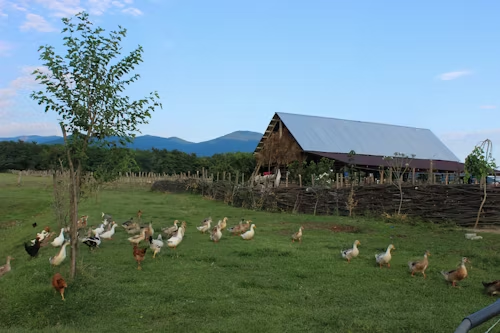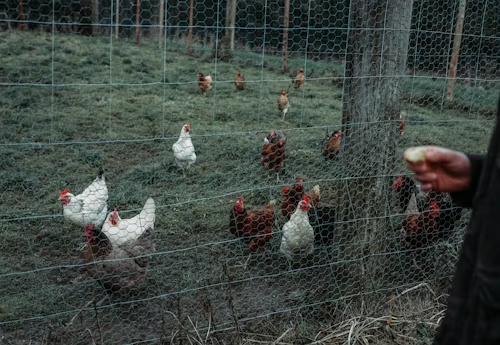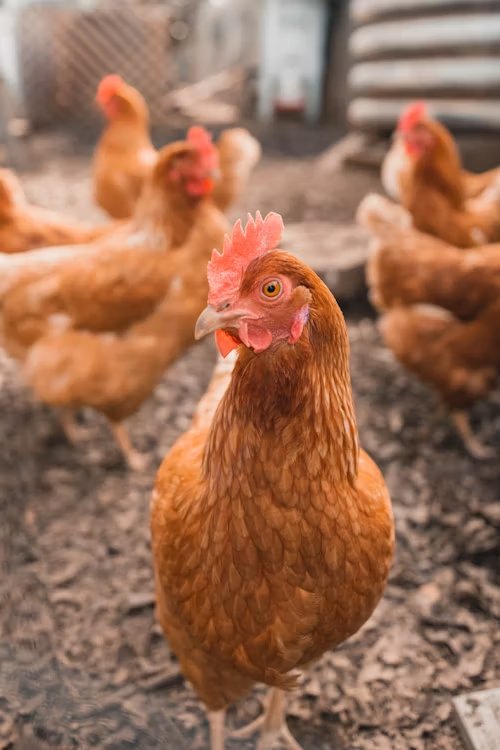Optimize your chickens' diet with natural, organic feeding approaches that boost egg quality and improve flock health.
The saying "you are what you eat" applies to chickens just as much as humans. What your chickens consume directly impacts the quality, taste, and nutritional value of the eggs they produce. By implementing organic feeding strategies, you can ensure your flock produces the healthiest, most nutritious eggs possible while supporting their overall wellbeing.
The Benefits of Organic Feeding
Transitioning to organic feeding practices offers numerous advantages:
- Enhanced egg nutrition: Studies show eggs from organically fed, free-range hens contain higher levels of omega-3 fatty acids, vitamins A and E, and beta carotene
- Improved flavor: Many backyard chicken keepers report that eggs from organically fed hens have richer taste and brighter yolks
- Better flock health: Natural feed ingredients support stronger immune systems and fewer health issues
- Environmental benefits: Organic feeding practices reduce chemical inputs and promote sustainability
- Peace of mind: Knowing exactly what goes into your chickens' diet and, by extension, your eggs

Foundation: Understanding Chicken Nutrition
Before diving into specific feeding strategies, it's important to understand the basic nutritional requirements of laying hens:
| Nutrient | Purpose | Natural Sources |
|---|---|---|
| Protein (16-18%) | Egg production, feather growth, tissue repair | Mealworms, black soldier fly larvae, sunflower seeds, peas, sprouted grains |
| Carbohydrates (55-60%) | Energy for daily activities | Corn, oats, wheat, barley, sprouted grains |
| Calcium (3.5-4%) | Eggshell formation | Crushed oyster shells, crushed eggshells, limestone |
| Vitamin A | Vision, immune function, egg production | Dark leafy greens, carrots, pumpkins, sweet potatoes |
| Vitamin D | Calcium absorption, egg quality | Sunlight exposure, fish meal (in limited amounts) |
| Omega-3 Fatty Acids | Anti-inflammatory, improves egg nutrition | Flaxseeds, chia seeds, leafy greens |
Feeding Tip:
Laying hens need approximately 0.25 pounds (about 1/4 cup) of complete feed per day, but this will vary based on breed, size, activity level, and supplemental foods provided.
Strategy 1: Organic Commercial Feed as Base
The foundation of most organic feeding programs is a certified organic commercial feed:
What to Look For
- USDA Organic certification: Ensures feed is produced without synthetic pesticides, herbicides, or fertilizers
- Non-GMO ingredients: Feed made from grains not genetically modified
- No animal by-products: Quality feeds avoid rendered animal products
- No synthetic additives: Avoid artificial colors, flavors, and preservatives
- Appropriate protein levels: 16-18% protein for laying hens
While organic commercial feed costs more than conventional feed, it provides a nutritionally balanced foundation that ensures your chickens receive essential nutrients in the right proportions. Use this as the base (approximately 80-90% of diet) and supplement with other organic options.
Strategy 2: Homegrown Supplementation
One of the most rewarding aspects of keeping backyard chickens is the ability to supplement their diet with items grown or produced on your own property:
Kitchen Garden for Chickens
Consider dedicating a section of your garden specifically for chicken-friendly plants:
Leafy Greens
Kale, spinach, Swiss chard, and lettuce are all excellent sources of vitamins and minerals. These greens boost egg nutrition and produce vibrant orange yolks.
Herbs
Oregano, thyme, mint, and sage have natural antibacterial and anti-parasitic properties. Herbs like parsley are rich in vitamins and can improve egg flavor.
Berries & Fruits
Strawberries, blueberries, and melons provide natural sugars for energy, along with antioxidants. Chickens particularly enjoy tomatoes and cucumbers.
Root Vegetables
Beets, carrots, and sweet potatoes can be grown specifically for your flock. These provide essential vitamins and can be fed raw, grated, or cooked.

Sprouting Grains and Seeds
Sprouting is a simple way to boost the nutritional value of grains and seeds:
- Sprouting increases protein content and vitamin levels while making nutrients more bioavailable
- Wheat, barley, oats, and sunflower seeds all sprout easily
- The sprouting process takes 2-5 days, depending on the grain
- Can be done in small batches using simple containers with drainage
Simple Sprouting Method:
- Rinse 1 cup of organic grain or seeds
- Soak for 8-12 hours in a jar with a mesh lid
- Drain thoroughly and rinse twice daily
- Harvest when sprouts are 1/4" to 1/2" long
- Feed to chickens fresh (will keep refrigerated for 3-5 days)
Strategy 3: Natural Foraging
Allowing your flock to forage naturally provides significant nutritional benefits:
Free-Range Benefits
- Chickens allowed to free-range consume a variety of insects, worms, seeds, and plants
- Research shows eggs from foraging hens have up to 2-3 times more omega-3 fatty acids
- Natural foraging provides exercise, reducing stress and obesity
- Foraging behavior satisfies chickens' instinctual needs, leading to fewer behavioral problems
If predator concerns or space limitations make free-ranging impractical, consider these alternatives:
- Mobile chicken tractors: Movable enclosures that allow access to fresh ground daily
- Scheduled free-range time: Allow foraging during supervised periods
- Deep litter system: Maintain 6-12 inches of bedding material like straw or wood shavings in the run, occasionally adding kitchen scraps, fallen leaves, or garden waste. This creates a composting ecosystem that generates insects and microorganisms for chickens to find.
Strategy 4: Raising Protein Sources
Protein is one of the most expensive components of organic feed. Consider producing your own protein supplements:
Mealworm Farming
Mealworms are easy to raise at home and provide excellent protein (up to 50%):
- Requires minimal space and setup costs
- Can be grown in plastic containers with oats, wheat bran, or other organic grain as bedding
- Produces continuous harvest after initial 2-3 month cycle
- Provides chickens with both nutrition and entertainment
Black Soldier Fly Larvae
These self-harvesting insects offer exceptional protein content (up to 45%):
- Commercial systems available or can be DIY constructed
- Convert kitchen waste into protein at remarkable efficiency
- Larvae contain balanced calcium to phosphorus ratio, beneficial for laying hens
- Adult flies are not pests and do not spread disease
Compost Systems
A well-maintained compost pile is a protein factory for chickens:
- Creates habitat for worms and beneficial insects that chickens can harvest
- Provides safe way to recycle kitchen scraps
- Chickens will help turn the compost as they search for treats
- Finished compost improves garden soil, creating a closed-loop system

Strategy 5: Seasonal Adjustments
Adapt your feeding strategy to match the changing seasons:
Spring
- Gradually introduce fresh greens as they become available
- Take advantage of natural protein boost from emerging insects
- Sprout seeds to provide transition from winter feeding
Summer
- Provide cooling fresh fruits and vegetables with high water content
- Feed during cooler morning and evening hours
- Reduce corn and other high-energy feeds that increase body heat
Fall
- Offer fallen fruits, pumpkins, squash, and garden clean-up
- Increase protein for chickens going through molt
- Gradually transition to winter feeding pattern
Winter
- Provide extra calories for warmth (organic corn in evening)
- Hang cabbages or other greens as activity and nutrition source
- Sprout grains indoors to provide living food
Strategy 6: Natural Supplements for Egg Quality
Calcium Sources
Adequate calcium is essential for strong eggshells:
- Offer crushed oyster shell in a separate container (free-choice)
- Clean and dry eggshells from your own flock, baked at 350°F for 10 minutes and crushed
- Naturally calcium-rich foods like broccoli leaves and kale
Omega-3 Boosters
Increase the omega-3 content of your eggs with these supplements:
- Flaxseeds (ground for better absorption)
- Chia seeds
- Leafy greens, especially purslane (which may grow wild in your yard)
- Small amounts of organic fish meal (use sparingly to avoid fishy-tasting eggs)
Natural Color Enhancers
For vibrant orange yolks, incorporate these natural color-enhancing foods:
- Marigold petals
- Carrots and carrot tops
- Paprika (small amounts mixed into feed)
- Red peppers
- Calendula flowers
Important Note:
While deep orange yolks are often associated with higher nutrition, color alone isn't a guaranteed indicator of nutritional value. Focus on providing a diverse, organic diet rather than solely aiming for color enhancement.
What to Avoid in Organic Feeding
An organic approach means eliminating harmful or questionable inputs:
- Processed foods: Avoid feeding chickens processed human foods containing preservatives, artificial flavors, or high salt content
- Toxic plants: Many common garden plants are harmful to chickens, including nightshades (unripe), avocado pits/skins, and rhubarb leaves
- Moldy or spoiled food: While chickens can eat many food scraps, anything moldy should be composted instead
- Excessive treats: Even healthy treats should make up no more than 10-20% of a chicken's diet to maintain proper nutrition
- Synthetic supplements: Opt for natural vitamin and mineral sources instead of artificial additives
Transitioning to Organic Feeding
When shifting to organic feeding, make changes gradually over 2-3 weeks:
- Begin by mixing organic feed with current feed, gradually increasing the organic proportion
- Introduce new supplements one at a time to monitor acceptance and any effects
- Observe egg quality, shell strength, and flock health during transition
- Keep detailed records of what works best for your specific flock
Conclusion: The Full-Circle Approach
The most successful organic feeding programs create a symbiotic relationship between chickens, garden, and kitchen:
- Kitchen scraps feed chickens and compost
- Chickens provide manure for garden fertility
- Gardens produce food for both humans and chickens
- Compost systems generate protein and convert waste to fertility
This integrated approach not only produces the healthiest eggs but also creates a sustainable, regenerative system that benefits your entire homestead. While it requires more planning and involvement than simply purchasing conventional feed, the rewards—superior nutrition, exceptional flavor, and the satisfaction of self-sufficiency—make it well worth the effort.
Remember that each flock is unique, and successful organic feeding involves observation and adaptation. Pay attention to egg quality, flock behavior, and overall health as you refine your approach to find what works best for your chickens and your specific environment.




Comments (2)
Maria J.
August 14, 2023I started supplementing my chickens' diet with sprouted grains last month and have noticed a significant improvement in the color and taste of the yolks! I'm excited to try growing black soldier fly larvae next.
Kevin P.
August 15, 2023The price difference between conventional and organic feed had me hesitating, but after implementing a compost system and growing some of my own supplements, I'm actually saving money while producing better eggs. The full-circle approach really works!
Leave a Comment